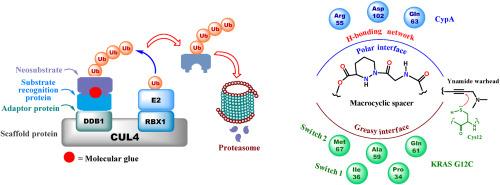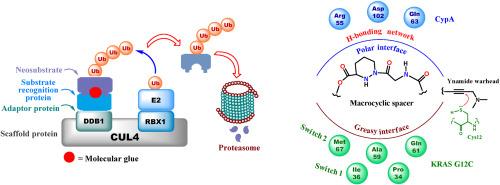Drugging the undruggable: Chemical and biological insights into molecular glues in the pipeline
IF 5.9
2区 医学
Q1 CHEMISTRY, MEDICINAL
引用次数: 0
Abstract
Recent advances in drug discovery have given rise to molecular glues, which present a unique chance to target functional proteins that were previously thought to be "undruggable" by traditional techniques. Molecular glues bridge the gap between biologics and conventional small-molecule protein inhibitors. They combine the advantageous pharmacokinetic profile of conventional small-molecule inhibitors with the target specificity of biologics in an innovative way. Furthermore, molecular glues get beyond the main drawbacks of other therapeutic approaches, namely the absence of distinct binding sites in difficult-to-target proteins for conventional small-molecule inhibitors and the drug-induced immunogenicity of biologics. This review delves into the conceptual and mechanistic underpinnings of molecular glues, from the accidental discovery of early immunomodulators like cyclosporin A through the investigation of thalidomide as a glue degrader to the current clinical evaluation of a diverse pipeline of structurally and mechanistically distinct molecular glues. The review identifies important binding motifs, common binding patterns, and hotspots at glue-induced protein interfaces through crystallographic data analysis of glue-induced ternary complexes. We aimed at broadening the therapeutic horizon of precision medicine by providing medicinal chemists with the fundamental concepts required for the rational design of next-generation molecular glues through the establishment of a structure-guided framework.


给无法治疗的药物下药:化学和生物学对分子胶在管道中的洞察
药物发现的最新进展导致了分子胶的出现,它提供了一个独特的机会来靶向以前被传统技术认为是“不可药物”的功能蛋白质。分子胶填补了生物制剂和传统小分子蛋白抑制剂之间的空白。他们以一种创新的方式将传统小分子抑制剂的优势药代动力学特征与生物制剂的目标特异性结合起来。此外,分子胶水克服了其他治疗方法的主要缺点,即传统小分子抑制剂难以靶向的蛋白质中缺乏独特的结合位点,以及生物制剂的药物诱导免疫原性。这篇综述深入探讨了分子胶的概念和机制基础,从意外发现的早期免疫调节剂如环孢素A,到对沙利度胺作为胶水降解剂的研究,再到目前对多种结构和机制不同的分子胶的临床评估。本文通过对胶诱导三元配合物的晶体学数据分析,确定了胶诱导蛋白界面的重要结合基序、常见结合模式和热点。我们旨在通过建立结构导向的框架,为药物化学家提供合理设计下一代分子胶所需的基本概念,从而拓宽精准医学的治疗视野。
本文章由计算机程序翻译,如有差异,请以英文原文为准。
求助全文
约1分钟内获得全文
求助全文
来源期刊
CiteScore
11.70
自引率
9.00%
发文量
863
审稿时长
29 days
期刊介绍:
The European Journal of Medicinal Chemistry is a global journal that publishes studies on all aspects of medicinal chemistry. It provides a medium for publication of original papers and also welcomes critical review papers.
A typical paper would report on the organic synthesis, characterization and pharmacological evaluation of compounds. Other topics of interest are drug design, QSAR, molecular modeling, drug-receptor interactions, molecular aspects of drug metabolism, prodrug synthesis and drug targeting. The journal expects manuscripts to present the rational for a study, provide insight into the design of compounds or understanding of mechanism, or clarify the targets.

 求助内容:
求助内容: 应助结果提醒方式:
应助结果提醒方式:


